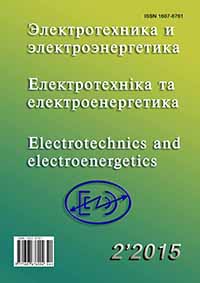THE DYNAMIC ADAPTATION OF CIRCUIT MODELS OF SHORT-CIRCUIT
DOI:
https://doi.org/10.15588/1607-6761-2015-2-9Keywords:
dynamic adaptation, circuit model, electrical parameters, electric resistance furnace, short-circuitsAbstract
The paper is devoted to the solution of actual scientific and applied problems of development of scientific and technical basis of optimization and efficient calculation of electrical supply systems of high-power industrial complexes of AC electric furnaces.The aim of research was to develop the dynamic adaptation method of circuit models of high-current conductors system of AC furnaces and to improve the accuracy and computational efficiency of calculations and correlation of the electromagnetic interaction effects with the electrical parameters of the current distribution in the bus systems.
The system of equations with the conditions of serial and parallel connections of electric circuits, the system of equations for the magnetic energy of these contours, the system of equations of self and mutual inductance contours were proposed for modeling processes in the AC high-current power supply systems of high-power furnaces.
The problem of the relative current error minimization is added, and determination of the adaptation vector projections is realized by the dynamic programming method. It allows to take into account the influence of the electromagnetic processes on the electrical parameters of the power systems of powerful electro-technological complexes of AC electric furnaces.
The experience of numerical realization of the method of circuit model dynamic adaptation of powerful high-current conductors of electric technological systems of AC furnaces shows the significant reduction in the cost of computing resources and time.
This method provides the higher accuracy of calculations as compared with known engineering techniques, and high effectiveness computation as compared with numerical realization of field models
References
Ярымбаш Д. С. Особенности контроля электрических параметров, мощности и энергопотребления во время кампании графитации в печи переменного тока / Ярымбаш Д. С., Ярымбаш С. Т., Тютюнник О. В. // Вісник Кременчуцького державного політехнічного університету. – Кременчук: КДПУ, 2006, – Вип. 3/2006(38), – С. 53 – 55.
Ярымбаш Д. С. Особенности определения параметров электрической схемы замещения печной петли печи графитации переменного тока / Д. С. Ярымбаш, И. М. Килимник, С. Т. Ярымбаш // Електротехніка та електроенергетика. – 2010. №2. – С. 36 – 43.
Канов Л. Н. Применения схемного моделирования для расчетов режимов электрических систем переменного тока / Л. Н. Канов // Електротехніка та електроенергетика. – 2009. №2. – С. 72 – 76.
Калантаров П. Л. Расчет индуктивностей: [справочная книга] / П. Л. Калантаров, Л. А. Цейтлин. – [3-е изд.] – Л.: Энергоатомиздат, 1986. – 488 с.
Данцис Я. Б. Короткие сети и электрические параметры дуговых электропечей / Я. Б. Данцис, Г. М.Жилов. – М.: Металлургия, 1987. – 320 с.
Ярымбаш Д. С. Повышение энергоэффективности электротехнического комплекса графитации при модернизации боковых шинных пакетов мощных печей графитации / Д. С. Ярымбаш, С. Т. Ярымбаш // Вісник СевНТУ: зб. наук. пр. Вип. 132/2012. Серія: Механіка, енергетика, екологія. — Севастополь, 2012. С. 93 – 100.
Ярымбаш Д. С. Применение адаптированных схемных моделей для расчета токов короткой сети мощных электротехнических комплексов / Д. С. Ярымбаш // Энергосбережение. Энергетика. Энергоаудит. – 2012. №2. – С. 72 – 76.
Арнольд В. И. Математические методы классической механики / В.И. Арнольд. – М.: Наука, 1989. – 472 с.
Аветисян, Д. А. Оптимальное проектирование электрических машин на ЭВМ / Аветисян Д. А., Соколов В. С., Хан В. С. — М.: Энергия, 1976. — 208 с.
Бахвалов Н. С. Численные методы / Н. С. Бахвалов, Н. П. Жидков, Г. М. Кобельков. – М.: Лаборатория Базовых Знаний, 2003. – 632 с.
Downloads
How to Cite
Issue
Section
License
Copyright (c) 2017 D. S. Yarymbash, I. M. Kilimnik, S. T. Yarymbash

This work is licensed under a Creative Commons Attribution 4.0 International License.
Creative Commons Licensing Notifications in the Copyright Notices
Authors who publish with this journal agree to the following terms:
Authors retain copyright and grant the journal right of first publication with the work simultaneously licensed under aCreative Commons Attribution License that allows others to share the work with an acknowledgement of the work's authorship and initial publication in this journal.
Authors are able to enter into separate, additional contractual arrangements for the non-exclusive distribution of the journal's published version of the work (e.g., post it to an institutional repository or publish it in a book), with an acknowledgement of its initial publication in this journal.
Authors are permitted and encouraged to post their work online (e.g., in institutional repositories or on their website) prior to and during the submission process, as it can lead to productive exchanges, as well as earlier and greater citation of published work.

